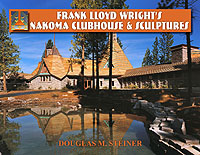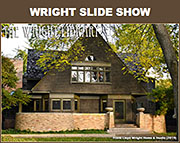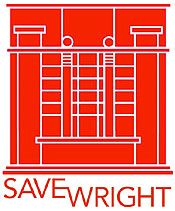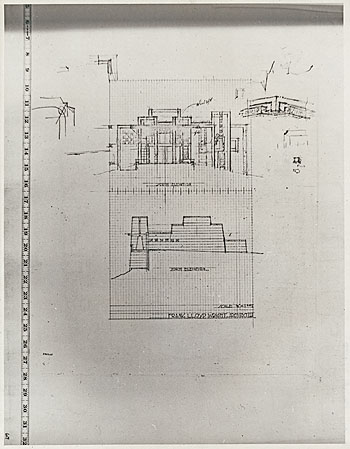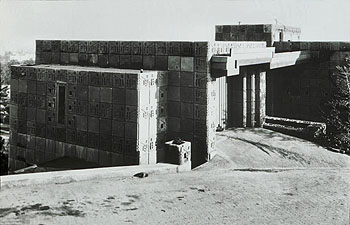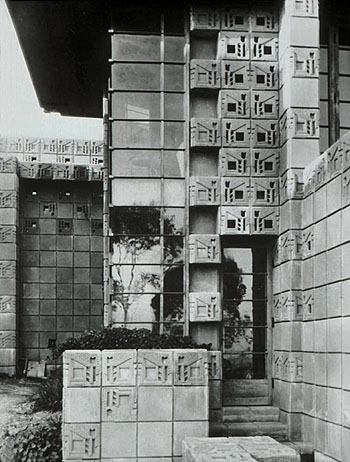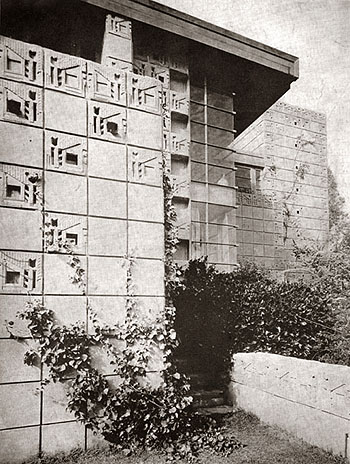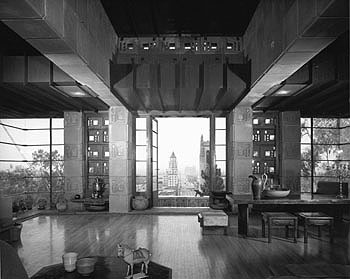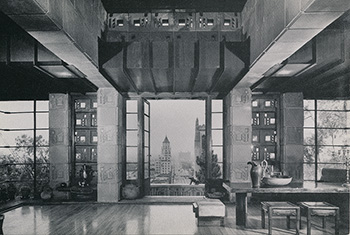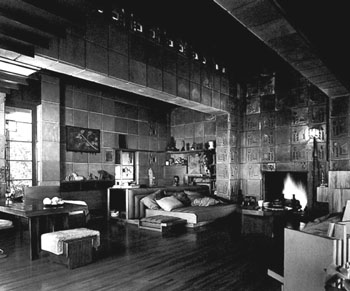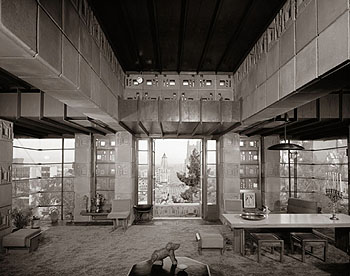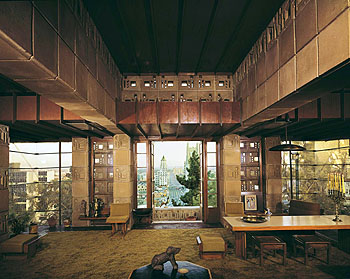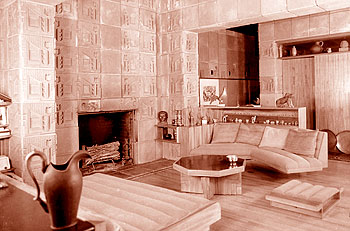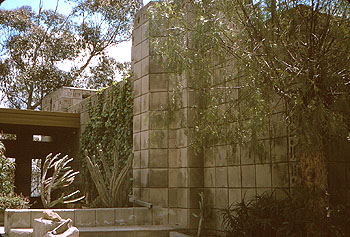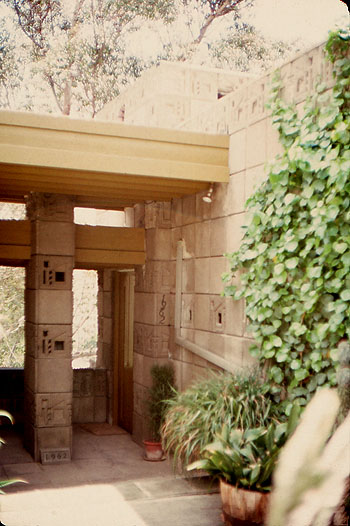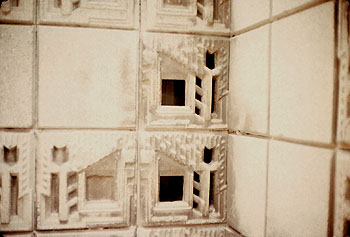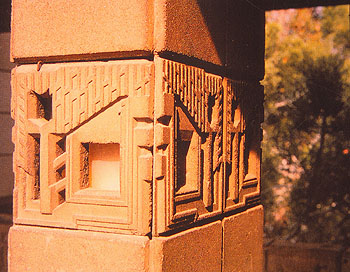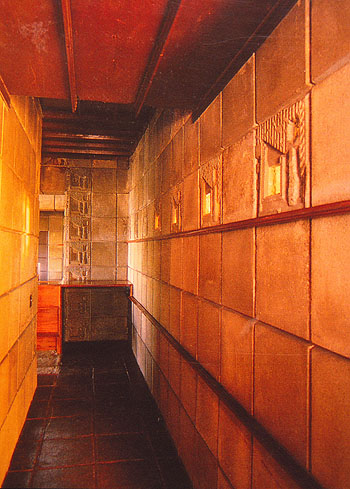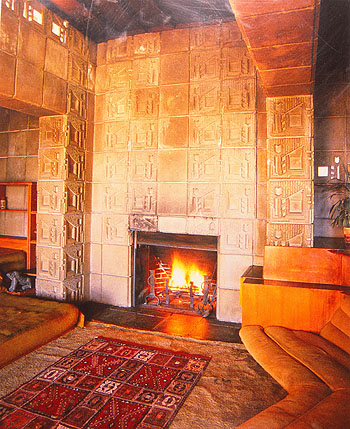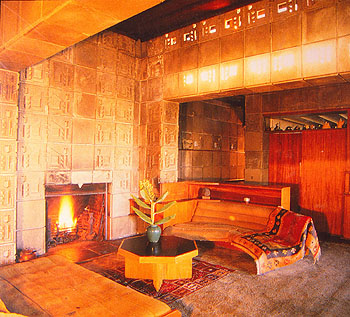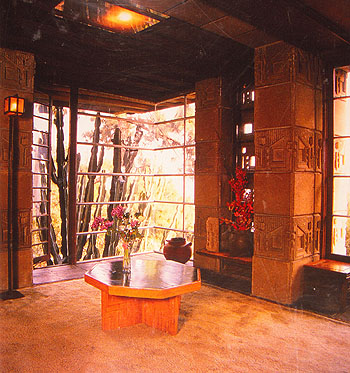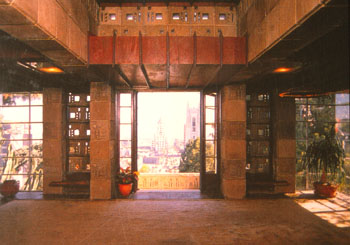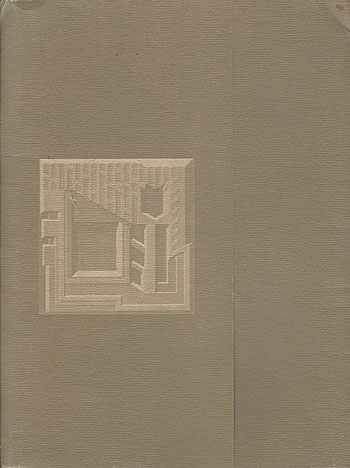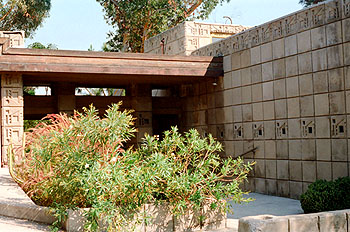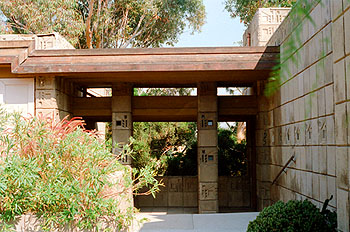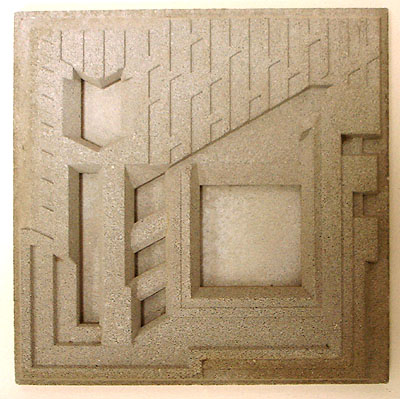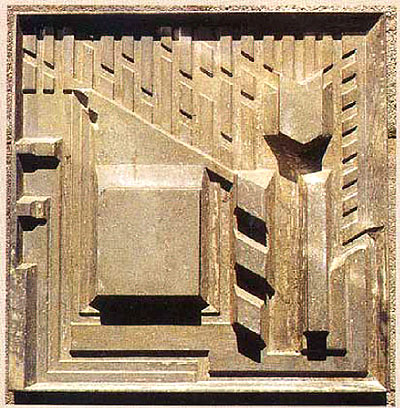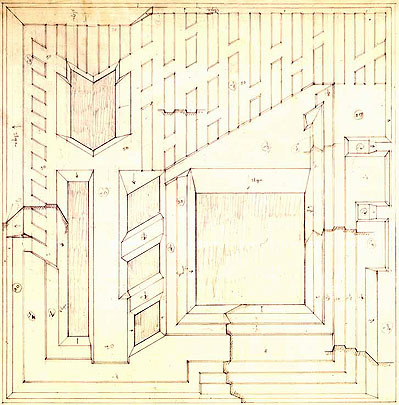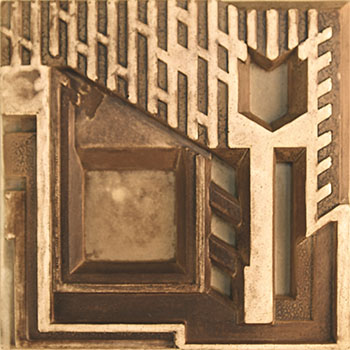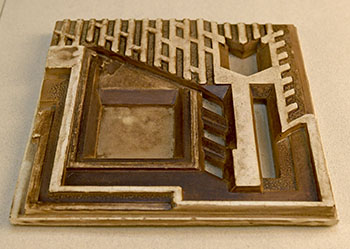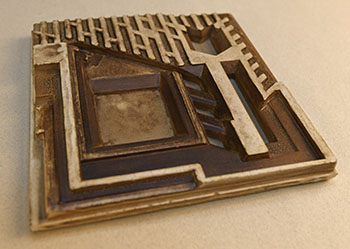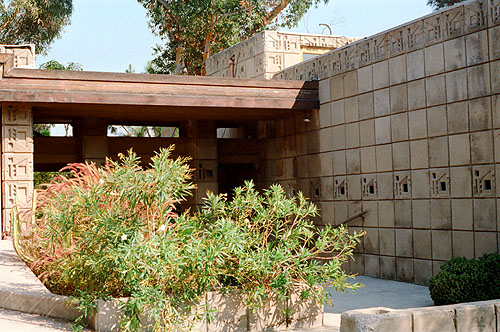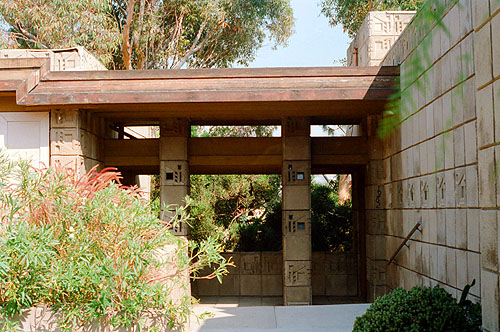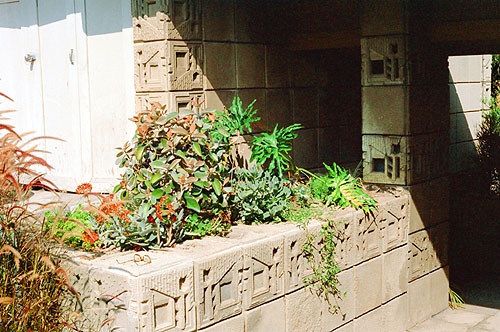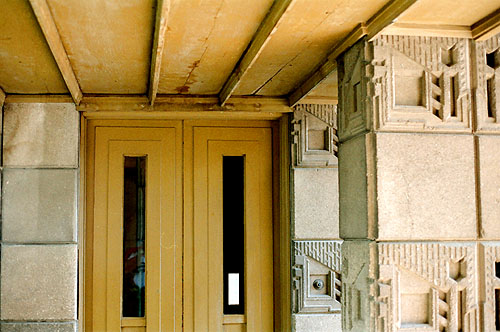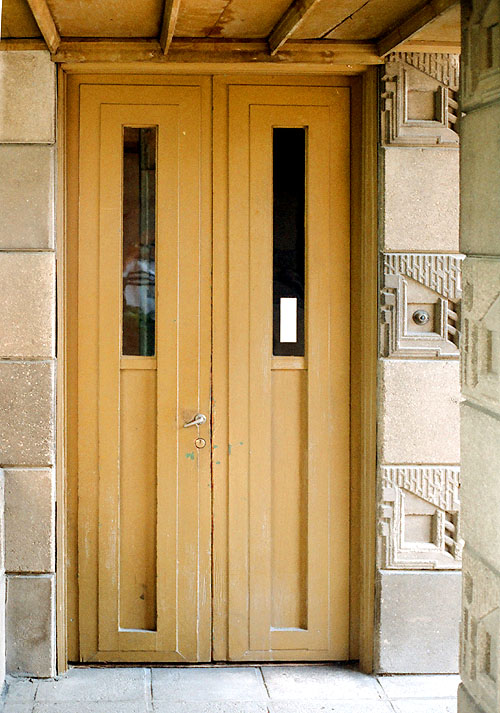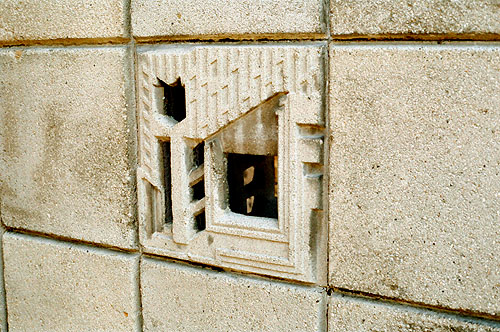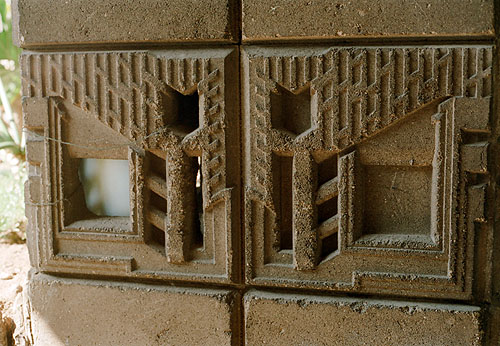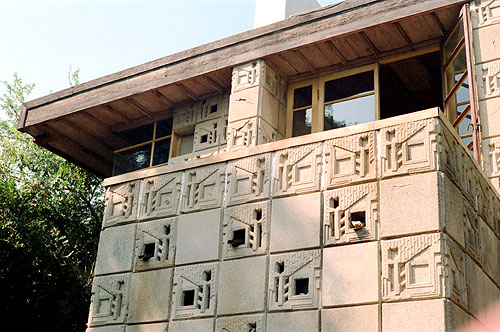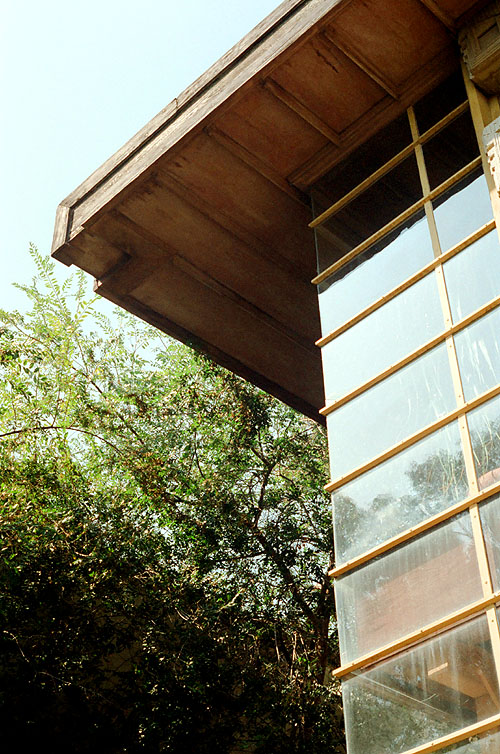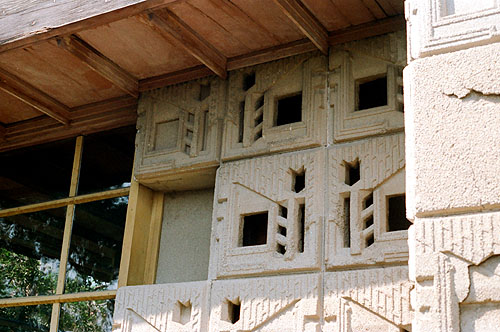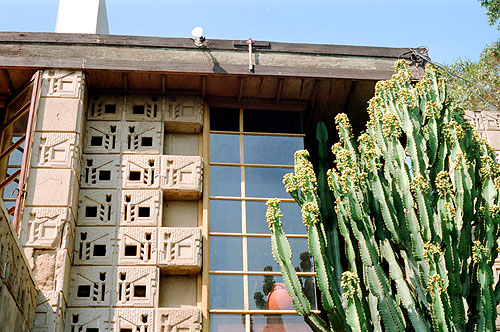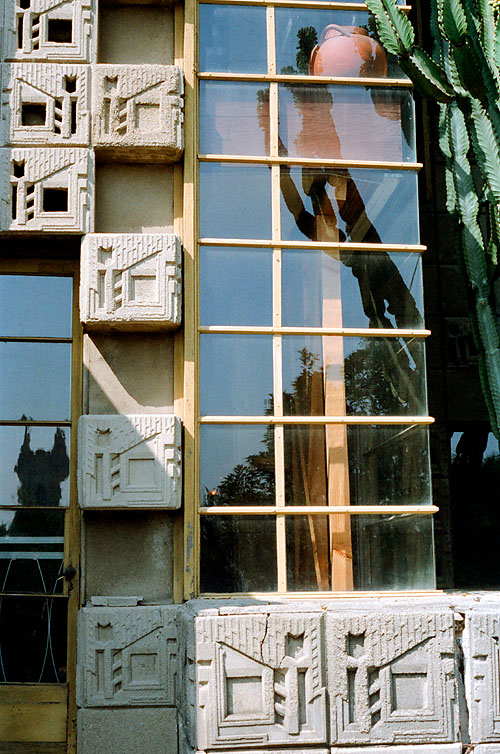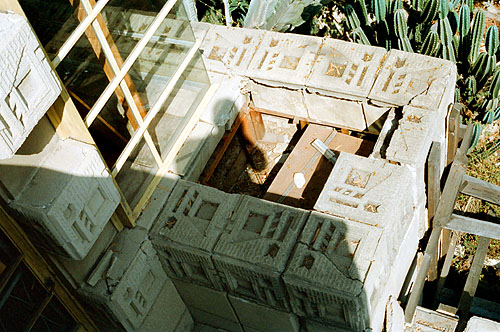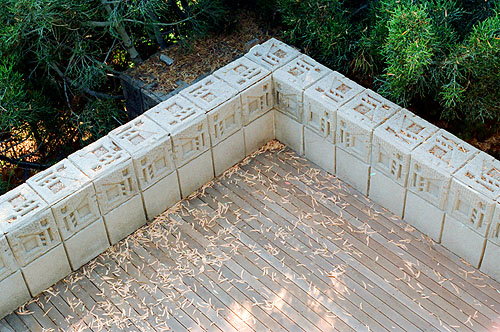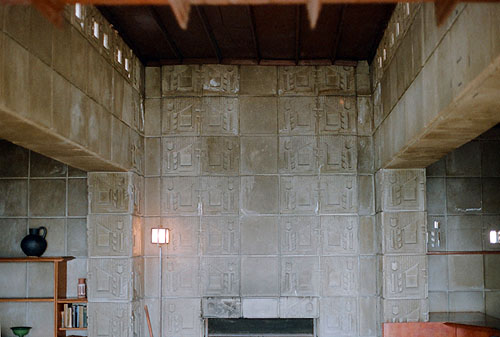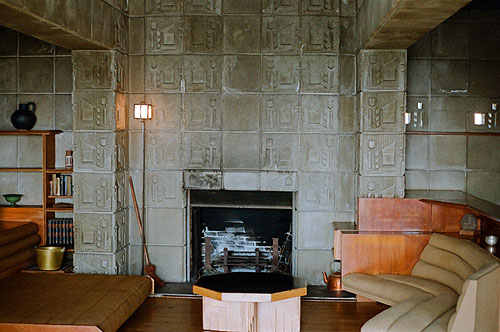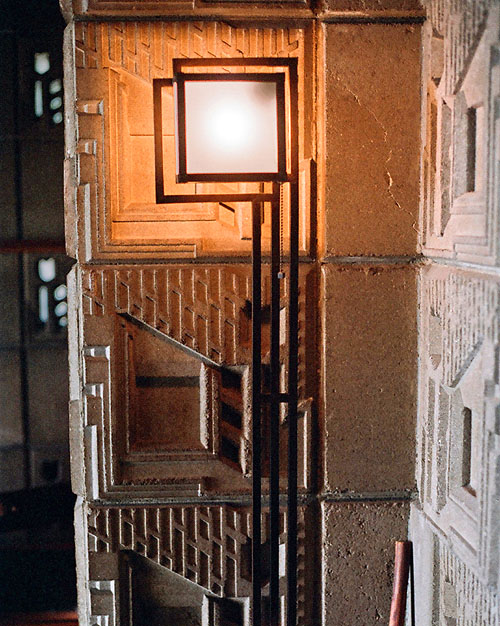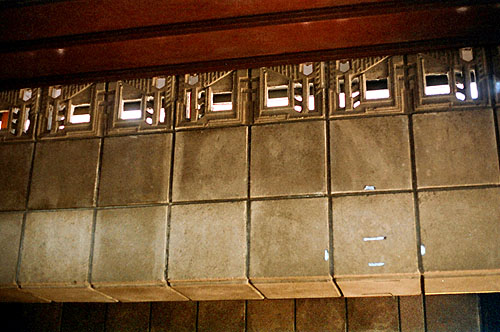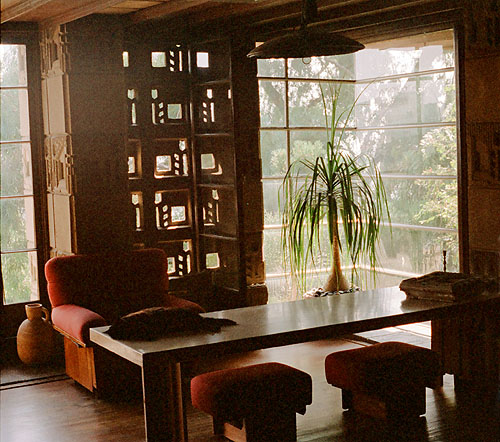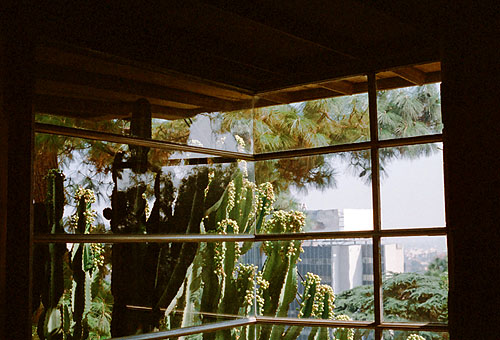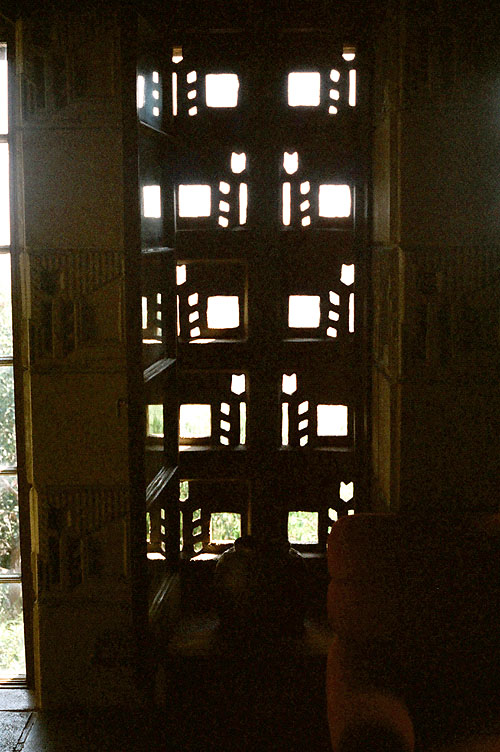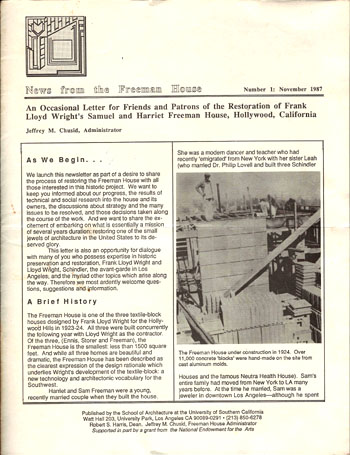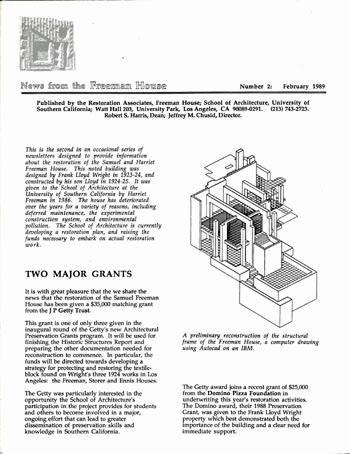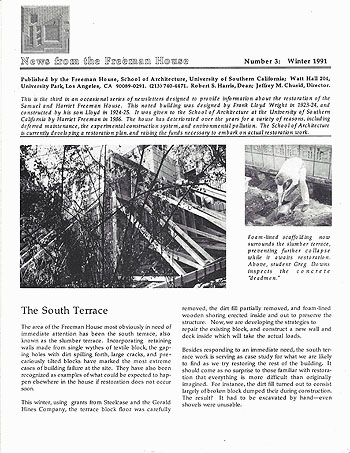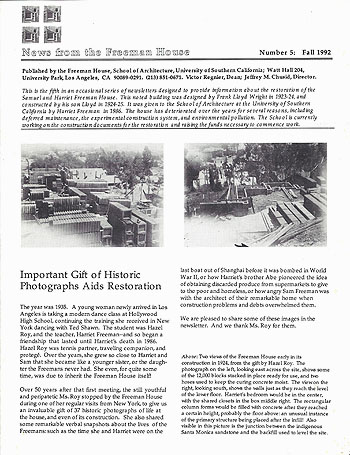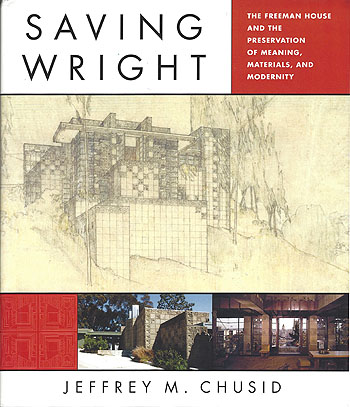
SUPPORT THE
WRIGHT LIBRARY
PROCEEDS FROM EVERY SALE GOES TO SUPPORT THE WRIGHT LIBRARY.
CLICK TO ORDER.
WE PROUDLY SUPPORT THE FRANK LLOYD WRIGHT FOUNDATION

WE PROUDLY SUPPORT THE FRANK LLOYD WRIGHT BUILDING CONSERVANCY
WE PROUDLY SUPPORT FALLINGWATER
AND THE WESTERN PENNSYLVANIA CONSERVANCY

SAMUEL FREEMAN RESIDENCE (1923 - S.216) Date: 1924
Title: Samuel and Harriet Freeman Residence 1924 - FLLW #2402 (1923 - S.216).
Description: Photograph of original drawing in the Frank Lloyd Wright Archives. North and South Elevations. Text: "South Elevation. North Elevation. Frank Lloyd Wright Architect." Hand written bottom left: "2402.05." For additional drawings, Frank Lloyd Wright, 1917-1942, Pfeiffer, 2010, p.117, 122-123.
Size: Original 10 x 8 B&W photograph.
S#: 0164.05.1219Date: Circa 1925 Title: Samuel and Harriet Freeman Residence Circa 1925. (1923 - S.216).
Description: Viewed from the Northwest. Designed by Frank Lloyd Wright in 1923, construction was supervised by Wright’s son, Lloyd Wright. A two-story home, the Entrance, Living Room, Balcony and Kitchen are on the main floor. The lower level includes two Bedrooms, Lounge, Bath and Storage. Both the West and East corners of the South elevation are formed by mitered glass corners that run the full length of two floors. This was Wright’s first use of mitered glass corners. Wright utilized this concept again in 1935 when he designed Fallingwater. Each textile block was 16" x 16". Wright continued the 16" measurement in the details of the design. Some blocks were perforated, glass was added, allowing additional light in, creating patters of light on the interior. The garage is on the left, the entrance is behind the garage, the Living Room is to the right. A planter box sits to the left of the garage, a pool is to the right. Photographed by Edward Van Altena.
Size: 10 x 6.5 B&W photograph.
S#: 0171.26.0216
Date: Circa 1925 Title: Samuel and Harriet Freeman Residence Circa 1925. (1923 - S.216).
Description: Viewed from the South, of the Southwest corner. Designed by Frank Lloyd Wright in 1923, construction was supervised by Wright’s son, Lloyd Wright. A two-story home, the Entrance, Living Room, Balcony and Kitchen are on the main floor. The lower level includes two Bedrooms, Lounge, Bath and Storage. Both the West and East corners of the South elevation are formed by mitered glass corners that run the full length of two floors. This was Wright’s first use of mitered glass corners. Wright utilized this concept again in 1935 when he designed Fallingwater. Each textile block was 16" x 16". Wright continued the 16" measurement in the details of the design. Some blocks were perforated, glass was added, allowing additional light in, creating patters of light on the interior. A built-in planter is in the foreground. The door to the right leads to the Bedroom, the Balcony is on the right. Photographed by Edward Van Altena.
Size: 10 x 6.5 B&W photograph.
S#: 0171.27.0216
Date: Circa 1928 Title: Samuel and Harriet Freeman Residence Circa 1928. (1923 - S.216).
Description: Viewed from the South, of the Southeast corner. Designed by Frank Lloyd Wright in 1923, construction was supervised by Wright’s son, Lloyd Wright. A two-story home, the Entrance, Living Room, Balcony and Kitchen are on the main floor. The lower level includes two Bedrooms, Lounge, Bath and Storage. Both the West and East corners of the South elevation are formed by mitered glass corners that run the full length of two floors. This was Wright’s first use of mitered glass corners. Wright utilized this concept again in 1935 when he designed Fallingwater. Each textile block was 16" x 16". Wright continued the 16" measurement in the details of the design. Some blocks were perforated, glass was added, allowing additional light in, creating patters of light on the interior. The Living Room balcony is on the left, bedroom closets below it. Stairs on the right lead to the bedroom. The kitchen and stairway are on the far right. Published in the August 1928 issue of Architectural Record, p.100.
Size: 8 x 10 B&W photograph.
S#: 0215.15.0216
Date: 1953 Title: Samuel and Harriet Freeman Residence 1953. (1923 - S.216).
Description: Viewed of the Living Room looking South. Designed by Frank Lloyd Wright in 1923, construction was supervised by Wright’s son, Lloyd Wright. A two-story home, the Entrance, Living Room, Balcony and Kitchen are on the main floor. The lower level includes two Bedrooms, Lounge, Bath and Storage. Both the West and East corners of the South elevation are formed by mitered glass corners that run the full length of two floors. This was Wright’s first use of mitered glass corners. Wright utilized this concept again in 1935 when he designed Fallingwater. Each textile block was 16" x 16". Wright continued the 16" measurement in the details of the design. Some blocks were perforated, glass was added, allowing additional light in, creating patters of light on the interior. The two center doors open out to the balcony. The floor to ceiling perforated textile blocks on the left and right are enclosed by a glass door. The floor is oak. Photographed by Julius Shulman.
Size: 10 x 8 B&W photograph.
S#: 0987.85.0216
Date: 1953
Title: Samuel and Harriet Freeman Residence, Los Angeles, California, 1953 (1923 - S.216).
Description: Postcard. Viewed of the Living Room looking South. Designed by Frank Lloyd Wright in 1923, construction was supervised by Wright’s son, Lloyd Wright. A two-story home, the Entrance, Living Room, Balcony and Kitchen are on the main floor. The lower level includes two Bedrooms, Lounge, Bath and Storage. Both the West and East corners of the South elevation are formed by mitered glass corners that run the full length of two floors. This was Wright’s first use of mitered glass corners. Wright utilized this concept again in 1935 when he designed Fallingwater. Each textile block was 16" x 16". Wright continued the 16" measurement in the details of the design. Some blocks were perforated, glass was added, allowing additional light in, creating patters of light on the interior. The two center doors open out to the balcony. The floor to ceiling perforated textile blocks on the left and right are enclosed by a glass door. The floor is oak. Photographed in 1953 by Julius Shulman. Similar view published in Julius Shulman, Gehry; Gossel, 1998, p.1926-27.
Text on Verso: “Frank Lloyd Wright, Architect. Freeman House: 1924, Los Angeles, California. Photograph: Julius Shulman. 18-152-5. Published by Museum Resources. Rimrock, California.”
Size: 6 x 4 B&W Postcard.
S#: 0987.139.1125Date: 1953 Title: Samuel and Harriet Freeman Residence 1953. (1923 - S.216).
Description: Viewed of the Living Room and fireplace looking Northwest. Designed by Frank Lloyd Wright in 1923, construction was supervised by Wright’s son, Lloyd Wright. A two-story home, the Entrance, Living Room, Balcony and Kitchen are on the main floor. The lower level includes two Bedrooms, Lounge, Bath and Storage. Both the West and East corners of the South elevation are formed by mitered glass corners that run the full length of two floors. This was Wright’s first use of mitered glass corners. Wright utilized this concept again in 1935 when he designed Fallingwater. Each textile block was 16" x 16". Wright continued the 16" measurement in the details of the design. Some blocks were perforated, glass was added, allowing additional light in, creating patters of light on the interior. The floor is oak. The floor lamps on the far left and far right were designed by Wright for the Storer House. Photographed by Julius Shulman.
Size: 10 x 8 B&W photograph.
S#: 0987.86.0216
Date: 1953 Title: Samuel and Harriet Freeman Residence 1953. (1923 - S.216).
Description: Viewed of the Living Room looking South. Designed by Frank Lloyd Wright in 1923, construction was supervised by Wright’s son, Lloyd Wright. A two-story home, the Entrance, Living Room, Balcony and Kitchen are on the main floor. The lower level includes two Bedrooms, Lounge, Bath and Storage. Both the West and East corners of the South elevation are formed by mitered glass corners that run the full length of two floors. This was Wright’s first use of mitered glass corners. Wright utilized this concept again in 1935 when he designed Fallingwater. Each textile block was 16" x 16". Wright continued the 16" measurement in the details of the design. Some blocks were perforated, glass was added, allowing additional light in, creating patters of light on the interior. The two center doors open out to the balcony. The floor to ceiling perforated textile blocks on the left and right are enclosed by a glass door. The oak floor has been covered in carpet. The floor lamps on the far right was designed by Wright for the Storer House. Photographed by Julius Shulman.
Size: 10 x 8 B&W photograph.
S#: 0987.87.0216
Date: 1953 Title: Samuel and Harriet Freeman Residence 1953. (1923 - S.216).
Description: Viewed of the Living Room looking South. Designed by Frank Lloyd Wright in 1923, construction was supervised by Wright’s son, Lloyd Wright. A two-story home, the Entrance, Living Room, Balcony and Kitchen are on the main floor. The lower level includes two Bedrooms, Lounge, Bath and Storage. Both the West and East corners of the South elevation are formed by mitered glass corners that run the full length of two floors. This was Wright’s first use of mitered glass corners. Wright utilized this concept again in 1935 when he designed Fallingwater. Each textile block was 16" x 16". Wright continued the 16" measurement in the details of the design. Some blocks were perforated, glass was added, allowing additional light in, creating patters of light on the interior. The two center doors open out to the balcony. The floor to ceiling perforated textile blocks on the left and right are enclosed by a glass door. The oak floor has been covered in carpet. The floor lamps on the far right was designed by Wright for the Storer House. Photographed by Julius Shulman.
Size: 10 x 8 Color photograph.
S#: 0987.88.0216
Date: Circa 1955
Title: Samuel and Harriet Freeman Residence Circa 1955. (1923 - S.216).
Description: View of the Living Room from the Southwest corner. The Entrance is down the hallway, the Kitchen is to the right. The built-in seating and attached shelves were designed by Rudolf Schindler. The octagonal table was designed by Frank Lloyd Wright as a Dining table to be placed between the Kitchen and Living Room. Hand written on sleeve: "Wright, Frank Lloyd. Freeman House, LA, 1924. Los Angeles."
Size: Original glass 35mm B&W slide and 10 x 8 high res digital image.
S#: 1092.104.0418Date: 1975
Title: Samuel and Harriet Freeman Residence viewed from the west 1975. (1923 - S.216).
Description: 1) The Garage is to the left, a built in planter box is in the foreground. The Entrance is toward the left in the background, the Living Room is to the right. The Freeman Residence was Frank Lloyd Wright’s third textile block home in California: 1) Millard (La Miniatura), 2) Storer, 4) Ennis. A two-story home, the Entrance, Living Room, Balcony and Kitchen are on the main floor. The lower level includes two Bedrooms, Lounge, Bath and Storage. Stamped on face: "33. May 75." Hand written on face: "Freeman House 1921, Glencoe. Frank Lloyd Wright." Printed on sleeve verso: "Kodachrome Transparency. Processed by Kodak.
Size: Original 35mm color slide, and 8 x 5.5 high res digital image.
S#: 1996.38.0718 (1)Date: 1975
Title: Samuel and Harriet Freeman Residence viewed from the west 1975. (1923 - S.216).
Description: 2) The Garage is to the left, the Entrance is in the center, the Living Room is to the right. The Freeman Residence was Frank Lloyd Wright’s third textile block home in California: 1) Millard (La Miniatura), 2) Storer, 4) Ennis. A two-story home, the Entrance, Living Room, Balcony and Kitchen are on the main floor. The lower level includes two Bedrooms, Lounge, Bath and Storage. Stamped on face: "34. May 75." Hand written on face: "Freeman House 1921, Glencoe. Frank Lloyd Wright." Printed on sleeve verso: "Kodachrome Transparency. Processed by Kodak.
Size: Original 35mm color slide, and 8 x 5.5 high res digital image.
S#: 1996.38.0718 (2)Date: 1975
Title: Samuel and Harriet Freeman Residence viewed from the west 1975. (1923 - S.216).
Description: 3) Detail of the patterned textile blocks. Three block patters are visible, plain, textile (L & R) and perforated. Stamped on face: "35. May 75." Hand written on face: "Freeman House 1921, Glencoe. Frank Lloyd Wright." Printed on sleeve verso: "Kodachrome Transparency. Processed by Kodak.
Size: Original 35mm color slide, and 8 x 5.5 high res digital image.
S#: 1996.38.0718 (3)Date: Circa 1990
Title: Samuel and Harriet Freeman Residence Circa 1990. (1923 - S.216).
Description: 1) View of the perforated textile block in the entry-court. The Freeman Residence was Frank Lloyd Wright’s third textile block home in California: 1) Millard (La Miniatura), 2) Storer, 4) Ennis. A two-story home, the Entrance, Living Room, Balcony and Kitchen are on the main floor. The lower level includes two Bedrooms, Lounge, Bath and Storage. Both the West and East corners of the South elevation are formed by mitered glass corners that run the full length of two floors. Wright utilized this concept again in 1935 when he designed Fallingwater. Each textile block was 16" x 16". Wright continued the 16" measurement in the details of the design. Some blocks were perforated, glass was added, allowing additional light into the Living Room, creating patters of light on the interior. Label on sleeve: "Wright, Frank Lloyd (1867-1959). Freeman House, Los Angeles, 1923. Block Lights in Entry Court. Am. Arch." Copy of image published in "Details of Frank Lloyd Wright, The California Work 1909-1974" Zimmerman, Dunham, 1994, p.61.
Size: Original glass 35mm color slide and 10 x 8 high res digital image.
ST#: 1990.138.0418 (1)Date: Circa 1990
Title: Samuel and Harriet Freeman Residence Circa 1990. (1923 - S.216).
Description: 2) Samuel and Harriet Freeman Residence Circa 1990. (1923 - S.216). View of the hall from the Entrance toward the Living Room. The Fireplace is straight ahead. The Freeman Residence was FLW’s third textile block home in California. Some blocks were perforated, glass was added, allowing additional light into the Living Room, creating patters of light on the interior. Label on sleeve: "Wright, Frank Lloyd (1867-1959). Freeman House, Los Angeles, 1923. Hallway - Entry to Living Room. Am. Arch." Copy of image published in "Details of Frank Lloyd Wright, The California Work 1909-1974" Zimmerman, Dunham, 1994, p.61.
Size: Original glass 35mm color slide and 10 x 8 high res digital image.
ST#: 1990.138.0418 (2)Date: Circa 1990
Title: Samuel and Harriet Freeman Residence Circa 1990. (1923 - S.216).
Description: 3) Samuel and Harriet Freeman Residence Circa 1990. (1923 - S.216). View of the Living Room from the Southeast corner. Each textile block was 16" x 16". Wright continued the 16" measurement in the details of the design. Label on sleeve: "Wright, Frank Lloyd (1867-1959). Freeman House, Los Angeles, 1923. Living Room. Am. Arch." Copy of image published in "Details of Frank Lloyd Wright, The California Work 1909-1974" Zimmerman, Dunham, 1994, p.57.
Size: Original glass 35mm color slide and 10 x 8 high res digital image.
ST#: 1990.138.0418 (3)Date: Circa 1990
Title: Samuel and Harriet Freeman Residence Circa 1990. (1923 - S.216).
Description: 4) Samuel and Harriet Freeman Residence Circa 1990. (1923 - S.216). View of the Living Room from the Southwest corner. The Entrance is down the hallway, the Kitchen is to the right. The built-in seating and attached shelves were designed by Rudolf Schindler. The octagonal table was designed by Frank Lloyd Wright as a Dining table to be placed between the Kitchen and Living Room. Label on sleeve: "Wright, Frank Lloyd (1867-1959). Freeman House, Los Angeles, 1923. Living Room. Am. Arch." Copy of image published in "Details of Frank Lloyd Wright, The California Work 1909-1974" Zimmerman, Dunham, 1994, p.58.
Size: Original glass 35mm color slide and 10 x 8 high res digital image.
ST#: 1990.138.0418 (4)Date: Circa 1990
Title: Samuel and Harriet Freeman Residence Circa 1990. (1923 - S.216).
Description: 5) Samuel and Harriet Freeman Residence Circa 1990. (1923 - S.216). View of the Living Room from the Northwest corner. Both the West and East corners of the South elevation are formed by mitered glass corners that run the full length of two floors. Wright utilized this concept again in 1935 when he designed Fallingwater. Each textile block was 16" x 16". Wright continued the 16" measurement in the details of the design. The octagonal coffee table, designed by FLW is most likely the same table seen in image #4. The bronze light fixture was designed by Wright, and is one of three created for the house. Label on sleeve: "Wright, Frank Lloyd (1867-1959). Freeman House, Los Angeles, 1923. Living Room. Am. Arch." Copy of image published in "Details of Frank Lloyd Wright, The California Work 1909-1974" Zimmerman, Dunham, 1994, p.60.
Size: Original glass 35mm color slide and 10 x 8 high res digital image.
ST#: 1990.138.0418 (5)Date: Circa 1990
Title: Samuel and Harriet Freeman Residence Living Room Circa 1990 (1923 - S.216).
Description: View of the Living Room from the South. Each textile block was 16" x 16". Wright continued the 16" measurement in the details of the design. Designed by Frank Lloyd Wright in 1923, construction was supervised by Wright’s son, Lloyd Wright. A two-story home, the Entrance, Living Room, Balcony and Kitchen are on the main floor. The lower level includes two Bedrooms, Lounge, Bath and Storage. Both the West and East corners of the South elevation are formed by mitered glass corners that run the full length of two floors. This was Wright’s first use of mitered glass corners. Label on sleeve: "Wright, Frank Lloyd (1867-1959). Freeman House, Los Angeles, 1923. Interior Looking Out. Am. Arch." Copy of image published in "Details of Frank Lloyd Wright, The California Work 1909-1974" Zimmerman, Dunham, 1994, p.59.
Size: Original glass 35mm color slide and 10 x 8 high res digital image.
ST#: 1990.139.0618Date: Circa 1991
Title: Freeman House (Folder) (Published by the University of Southern California, School of Architecture)
Author: University of Southern California
Description: Presentation Folder. Cover: Embossed Freeman House Block. Flap: "Freeman House. School of Architecture, 2-4 Watt Hall, University of Southern California, Los Angeles, California 90089-0291."
Size: 9 x 12
Pages: Pp 6
ST#: 1991.83.0616Date: 1995 Title: Samuel and Harriet Freeman Residence 1995. (1923 - S.216). Set of 24 photographs.
Description: The Freeman Residence was Frank Lloyd Wright’s third textile block home in California: 1) Millard (La Miniatura), 2) Storer, 4) Ennis. A two-story home, the Entrance, Living Room, Balcon and Kitchen are on the main floor. The lower level includes two Bedrooms, Lounge, Bath and Storage. Both the West and East corners of the South elevation are formed by mitered glass corners that run the full length of two floors. Wright utilized this concept again in 1935 when he designed Fallingwater. Each textile block was 16" x 16". Wright continued the 16" measurement in the details of the design. Some blocks were perforated, glass was added, allowing additional light into the Living Room, creating patters of light on the interior. Deterioration of the textile block is very evident. Set of 24 photographs taken during a trip to California in 1995.
Size: 24 Original 6" x 4" Color Photographs and 13" x 9" High Res Digital Images.
S#: 1995.78.0216 1-24
Continue to additional photographs.
Date: 2004 Title: Samuel Freeman House Concrete Block, 2004 (1923 - S.216).
Description: The Samuel and Harriet Freeman House is one of the four textile-block houses designed by Frank Lloyd Wright in California. During construction, dirt was mixed in with the concrete to give it a more natural look but the compound proved to be unstable. Wright was out of the country at the time working on the Imperial Hotel in Tokyo. He dispatched his associate, Rudolf Schindler to come up with a solution. Schindler filled the gaps in the textile blocks with mortar as a means to stabilize them, however the changes compromised the design aesthetic and infuriated Wright. Schindler's "transgressions" brought about the end of their relationship. In 1986, the house which the Freemans lived in for 61 years was given to the University of Southern California School of Architecture. The house was badly damaged by the Northridge Earthquake in 1994. The home is under going a major restoration. This block is poured from the original mold for the restoration. Two blocks.
Size: 16 x 16"
ST#: 2004.37.0207, 2004.38.0207
Freeman House Original Block Mold Freeman House Block Drawing Date: 2022
Title: Samuel and Harriet Freeman Residence, Los Angeles, California, Tile Replica 1922 (1923 - S.216).
Description: Handcrafted ceramic tile replica of the Freeman House block. Designed by Frank Lloyd Wright in 1923. The Samuel and Harriet Freeman House is one of the four textile-block houses designed by Frank Lloyd Wright in California.
Size: 5.5 x 5.5 x .5
ST#: 2022.03.1022SAMUEL FREEMAN RESIDENCE 1995
NEWS FROM THE FREEMAN HOUSE Date: 1987
Title: News From the Freeman House - Number 1: November 1987 (Published by the School of Architecture at the University of Southern California, Los Angeles, CA)
Author: Chusid, Jeffrey M.
Description: "An Occasional Letter for Friends and Patrons of the Restoration of FLW’s Samuel and Harriet Freeman House, Hollywood, California." Sections of the newsletter include: 1) As We Begin... We launch this newsletter as part of a desire to share the process of restoring the Freeman House with all those interested in this historic project... 2) A Brief History. 3) The Restoration. 4) Joining in the Restoration. 5) The Architect in Residence. 6) A Videotape Introduction. 7) A Wright Festival in Los Angeles. 8) The People Involved. Includes four photographs and four illustration. Two copies. Gift of Kathryn Smith.
Size: 8.5 x 11
Pages: Pp 6
ST#: 1987.90.0616Date: 1989
Title: News From the Freeman House - Number 2: February 1989 (Published by the Restoration Association, Freeman House; School of Architecture, University of Southern California, Los Angeles, CA)
Author: Harris, Robert S.; Chusid, Jeffrey M.
Description: "This is the second in an occasional series of newsletters designed to provide information about the restoration of the Samuel and Harriet Freeman House. This noted building was designed by FLW in 1923-24, and constructed by his son Lloyd in 1924-25." Sections of the newsletter include: 1) Two Major Grants. 2) Student Research. 3) Work in Progress. 4) Reproductions of the Textile Block. 5) Westweek, CPF, and LA Conservancy Tours. Includes five photographs and one illustration. Gift of Kathryn Smith.
Size: 8.5 x 11
Pages: Pp 6
ST#: 1989.103.0616Date: 1991
Title: News From the Freeman House No. 3: Winter 1991 (Published by the Restoration Association, Freeman House; School of Architecture, University of Southern California, Los Angeles, CA)
Author: Harris, Robert S.; Chusid, Jeffrey M.
Description: "This is the second in an occasional series of newsletters designed to provide information about the restoration of the Samuel and Harriet Freeman House. This noted building was designed by Frank Lloyd Wright in 1923-24, and constructed by his son Lloyd in 1924-25." Sections of the newsletter include: 1) The South Terrace. 2) The Committee for the Restoration. 3) Phases of the Restoration. 4) A Restoration Strategy. 5) Student Restoration. 6) Exhibits and Publications. 7) Concrete Tiles, Textile Blocks and Name-A-Block Program. Includes six photographs and two illustrations. Gift of Kathryn Smith.
Size: 8.5 x 11.
Pages: Pp 6
ST#: 1991.82.0616Date: 1992
Title: News From the Freeman House No. 5: Fall 1992 (Published by the Restoration Association, Freeman House; School of Architecture, University of Southern California, Los Angeles, CA)
Author: Regnier, Victor; Chusid, Jeffrey M.
Description: "This is the second in an occasional series of newsletters designed to provide information about the restoration of the Samuel and Harriet Freeman House. This noted building was designed by Frank Lloyd Wright in 1923-24, and constructed by his son Lloyd in 1924-25." Sections of the newsletter include: 1) Important Gift of Historic Photographs Aids Restoration. 2) Frank Lloyd Wright’s 125th Brings Together Great Architecture, Food and People. 3) Public Education Programs. 4) Public Tours. 5) The Freeman House and the Holidays. 6) Block Houses to Become California State Landmark. 7) Restoration Progress. 8) Freeman House Study Tour: Modernism in Palm Springs. 9) The Restoration Associates. Includes 11 photographs. Gift of Kathryn Smith.
Size: 8.5 x 11.
Pages: Pp 6
ST#: 1992.111.0616Date: 2011
Title: Saving Wright. The Freeman House and The Preservation of Meaning, Materials, and Modernity (Hard Cover DJ) (Published by W. W. Norton &Company, New York, London)
Author: Chusid, Jeffrey M.
Description: "Saving Wright chronicles the ongoing struggle to save Wright’s Freeman House in the Hollywood Hills, the setting for fascinating people and events but deeply flawed from the time it was built ninety-five years ago. The Freeman House was an experiment born out of Frank Lloyd Wright’s polemical vision of a new kind of architecture for the middle class, for modern America, and, in particular, for the Los Angeles foothills. Its design and construction were difficult, thus, along with many poor decisions, planting within a beautiful work of architecture the seeds of its own destruction." (Publisher’s description.) Original list price $55.00. (First Edition)
Size: 8.75 x 10.25
Pages: Pp 256
ST#: 2011.16.0317
HOME ARTIFACTS AUDIO BOOKS PERIODICALS PHOTOS POSTCARDS POSTERS STAMPS STUDIES ASSISTING ABOUT SLIDE SHOW To donate or pass on information, comments or questions:
steinerag@msn.com
©Copyright Douglas M. Steiner, 2001, 2025
